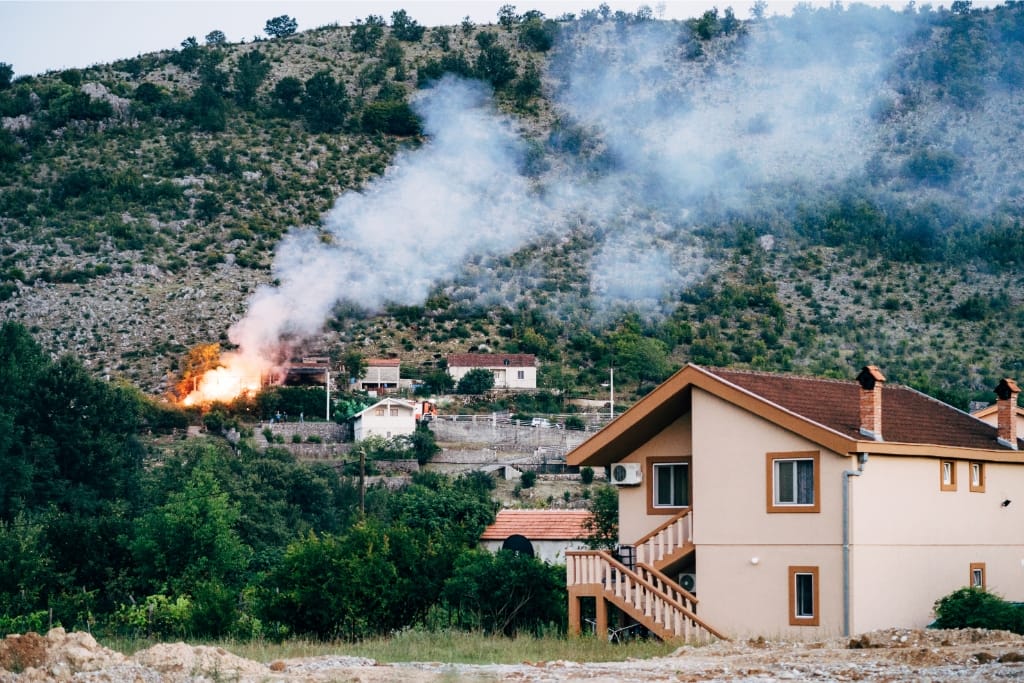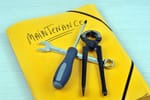Wildfires can leave a lasting impact not only on the landscape but also on our homes and belongings, primarily through smoke damage.
This guide aims to provide homeowners with essential steps to effectively address and manage the aftermath of smoke exposure.
Prompt action is crucial in mitigating potential health risks and preserving valuable items.
By assessing the damage, engaging in thorough cleaning and restoration, and implementing preventive measures for the future, individuals can reclaim their spaces and safeguard against further issues.
Whether you're dealing with minor smoke residue or significant damage, this comprehensive approach will help you navigate the recovery process.
Smoke damage can profoundly affect homes, leading to both aesthetic and health-related concerns.
When materials burn, they produce harmful byproducts, including soot, particulate matter, and volatile organic compounds (VOCs), which can infiltrate homes and contaminate indoor air quality.
This type of damage is not only superficial; it can permeate walls, furniture, and textiles, resulting in persistent odors and potential respiratory issues for occupants.
Smoke damage can complicate the restoration process, as it often requires specialized cleaning methods to remove residues and odors effectively.
Understanding the breadth and severity of smoke damage is essential for homeowners to take informed steps toward recovery and restoration.
Addressing smoke damage promptly is crucial to safeguard both health and property.
The longer smoke residues are allowed to settle, the more difficult and costly it becomes to remove them.
Delayed action can lead to increased health risks, as persistent exposure to smoke can exacerbate respiratory conditions and create long-term indoor air quality issues.
Immediate assessment and intervention not only help preserve valuable belongings but also minimize the potential for structural damage to the home.
Furthermore, prompt action can enhance the chances of a successful insurance claim, as timely documentation and cleanup are often necessary to support recovery efforts.
By prioritizing quick and effective responses, homeowners can significantly mitigate the negative impacts of smoke damage.
Step 1: Assessing The Damage
Assessing the damage is the critical first step in addressing smoke damage after a wildfire.
This phase involves a careful and systematic evaluation of the affected areas to determine the extent of the impact on both the structure and contents of the home.
By identifying which rooms and belongings have been compromised, homeowners can create a comprehensive remediation plan.
Understanding the severity of the damage will guide decisions on whether items can be cleaned or if they need to be replaced entirely.
Proper documentation during this assessment is also essential for insurance claims and future recovery efforts.
Taking the time to thoroughly assess the damage lays the foundation for effective cleaning and restoration, ensuring that no aspect of the problem is overlooked.
Pro Tip: Easy Way To Manage Projects
Utilizing a simple printable home project planner can greatly enhance the management of projects affected by smoke damage, providing homeowners with a structured approach to tackle necessary repairs and improvements.
This planner allows individuals to prioritize tasks, set clear deadlines, and allocate resources effectively, ensuring that no aspect of recovery is overlooked.
By breaking down larger projects into manageable steps, homeowners can track progress and stay organized, alleviating the stress often associated with dealing with repairs.
Furthermore, having a physical document to reference facilitates ongoing communication with professionals or family members involved in the restoration process, ultimately leading to a more efficient and streamlined recovery from smoke damage.
Inspect The Affected Areas
Identify Rooms And Belongings Impacted By Smoke
Identifying the specific rooms and belongings impacted by smoke is essential for effective remediation.
Begin by systematically examining each area of the home, paying close attention to spaces that are connected to the outdoors or where smoke may have had direct exposure.
Commonly affected areas often include living rooms, kitchens, and bedrooms, where furniture, carpeting, and personal items can absorb smoke particles.
It's crucial to evaluate not only the visible surfaces but also hidden spaces, such as closets and behind furniture, where soot may settle unnoticed.
Create an inventory of compromised items, distinguishing between those that may be salvageable and those that are beyond repair.
This detailed identification process will help prioritize cleaning efforts and inform decisions regarding replacement or deep cleaning, ensuring a comprehensive approach to restoring the home.
Document Damage For Insurance Purposes
Documenting damage for insurance purposes is a vital step in ensuring a smooth recovery process after experiencing smoke damage.
Homeowners should take detailed photographs and videos of affected areas and belongings, capturing all visible signs of smoke residue and any harm incurred.
It's important to include shots of entire rooms as well as close-ups of damaged items to provide clear evidence of the extent of the damage.
Creating a written list that enumerates each item, its condition, and its estimated value will bolster the documentation.
This thorough record not only helps streamline insurance claims but also serves as a reference for assessing the cost of potential repairs and replacements.
By meticulously documenting the damage, homeowners can significantly facilitate the insurance process and enhance their chances of receiving appropriate compensation.
Evaluate The Severity
Determine If It's Cleanable Or Requires Replacement
Determining whether items affected by smoke damage are cleanable or require replacement is a crucial decision that can significantly impact the recovery process.
This evaluation hinges on several factors, including the nature of the material, the extent of the damage, and the severity of the smoke exposure.
For items made of durable materials, such as metal or certain plastics, professional cleaning methods may restore their original condition.
However, porous materials, like upholstery, carpeting, or drywall, may absorb smoke and residues more deeply, potentially making them irreparable.
Beloved personal items or important documents, despite being hard to part with, must also be assessed with practicality in mind.
Consulting with restoration professionals can provide valuable insight into the best course of action, ensuring that decisions made will effectively safeguard health and preserve the integrity of the home.
Check For Hidden Smoke Damage Or Odors
Checking for hidden smoke damage or lingering odors is a critical step in the remediation process.
Even after visually inspecting the affected areas, some damage may remain undetected, particularly in concealed spaces like attics, basements, and within walls.
Smoke can permeate porous materials and hard-to-reach spots, leading to persistent odors that are difficult to eliminate.
Homeowners should conduct a thorough examination of these hidden areas, using tools such as moisture meters to identify potential issues behind surfaces.
Employing professional smoke odor detection techniques, such as thermal imaging, can help locate residual particles that may not be immediately visible.
By addressing hidden smoke damage and odors proactively, homeowners can ensure a complete restoration, promoting a healthier indoor environment.
Gather Necessary Supplies
Create A List Of Tools And Materials Needed For Cleanup
Creating a list of tools and materials needed for cleanup is essential for an efficient and effective remediation process after smoke damage.
This inventory should include personal protective equipment (PPE) such as gloves, masks, and goggles to safeguard against inhaling hazardous particles.
Cleaning supplies will be paramount, so ensure to include an assortment of non-toxic cleaners, sponges, brushes, and microfiber cloths.
Additional tools like vacuums equipped with HEPA filters, steam cleaners, and deodorizing agents can significantly assist in removing soot and odors.
Don’t forget to list waste disposal bags and containers for safely transporting damaged items, as well as air purifiers to help restore air quality post-cleanup.
Having this comprehensive list at hand will streamline the cleanup process, ensuring that no critical supplies are overlooked.
Acquire Safety Gear To Protect From Hazardous Materials
Acquiring safety gear to protect against hazardous materials is a crucial step in preparing for cleanup after smoke damage.
Homeowners should invest in high-quality personal protective equipment (PPE) that includes N95 respirators or masks to filter out fine soot particles and harmful chemicals.
Heavy-duty gloves are essential for protecting the skin from irritants, while goggles or safety glasses can shield the eyes from dust and debris.
Wearing long-sleeved clothing and sturdy footwear can help prevent injuries while navigating through affected areas.
It’s also wise to consider using coveralls or disposable suits for full-body protection, especially when handling damaged items or cleaning contaminated surfaces.
By ensuring that the proper safety gear is gathered beforehand, individuals can approach the cleanup process with greater confidence and minimize health risks.
Step 2: Cleaning And Restoration
Once the initial assessment and documentation of smoke damage have been completed, the next critical phase involves cleaning and restoration.
This step is vital in reclaiming the affected space and ensuring that it is not only aesthetically pleasing but also safe for inhabitants.
It encompasses a range of activities, from removing soot and residue from surfaces to applying specialized treatments for lingering odors.
Depending on the severity of the damage, homeowners may choose to tackle the cleanup themselves or enlist the expertise of professionals.
A systematic approach during this phase, guided by safety protocols and effective cleaning methods, will significantly enhance the chances of successful restoration, allowing for the home to return to its pre-damage condition.
Remove Contaminated Items
Discard Any Severely Damaged Or Contaminated Belongings
Discarding any severely damaged or contaminated belongings is imperative to ensure a thorough and effective restoration process following smoke damage.
Items that have been extensively charred, soaked in water, or deeply embedded with smoke residues may pose health risks and can be nearly impossible to restore.
This includes items such as burnt furniture, heavily soiled textiles, and appliances that have been affected by fire or smoke exposure.
When assessing which items to discard, homeowners should err on the side of caution, as retaining damaged belongings can lead to ongoing odors, potential mold growth, and further contamination.
It is advisable to document discarded items for insurance purposes and, when possible, arrange for the safe disposal of hazardous waste following local regulations.
By eliminating severely affected belongings, homeowners can facilitate a cleaner, healthier living environment as they move forward with the restoration efforts.
Separate Items Into Salvageable And Non-Salvageable Groups
Separating items into salvageable and non-salvageable groups is a critical step in the cleanup process following smoke damage.
This methodical classification enables homeowners to efficiently assess what can be restored versus what needs to be discarded.
Salvageable items may include personal belongings that have minor smoke damage, such as clothing, books, or certain types of furniture that can be cleaned and deodorized effectively.
On the other hand, non-salvageable items are those that are extensively charred, heavily soiled, or pose health risks due to contamination.
It’s important to approach this division with a keen eye and a clear mindset, as the decision to keep or discard can significantly influence the overall restoration effort.
Properly documenting each category will also assist in the insurance claim process, ensuring that all losses are accounted for and addressed.
By taking the time to thoughtfully separate items, homeowners can streamline the restoration journey and promote a healthier, more organized living space moving forward.
Deep Clean Surfaces
Use Appropriate Cleaning Solutions For Different Surfaces
Using appropriate cleaning solutions for different surfaces is essential in effectively removing soot and smoke residues while preserving the integrity of various materials.
Different surfaces require tailored cleaning agents; for instance, non-porous surfaces like glass and metal can generally handle stronger cleaners, including degreasers or vinegar solutions.
Conversely, porous surfaces such as upholstery or wood may necessitate gentler, pH-balanced cleaners specifically designed to prevent further damage.
It's also crucial to consider the manufacturer's guidelines for each type of material. Testing any cleaning solution on an inconspicuous area first can help ensure it does not cause discoloration or degradation.
By selecting the right cleaning products for each surface, homeowners can achieve optimal results in their restoration efforts while safeguarding their belongings.
Employ Methods Such As Scrubbing, Vacuuming, And Air Purification
Employing methods such as scrubbing, vacuuming, and air purification is vital in ensuring a comprehensive cleaning process after smoke damage.
Scrubbing surfaces not only helps lift stubborn soot and residue but also allows for a deeper clean that can enhance the effectiveness of the cleaning solutions used.
Vacuuming, particularly with a vacuum equipped with a HEPA filter, is crucial for removing fine particulates that might not be visible to the naked eye, thereby improving indoor air quality.
Utilizing air purifiers can help eliminate lingering smoke odors and airborne contaminants, providing a fresher environment.
Combining these methods creates a multi-faceted approach to cleaning, significantly contributing to the restoration of the home and the well-being of its inhabitants.
By incorporating these techniques into the cleanup efforts, homeowners can help ensure that their living space is not only visually restored but also safe and healthy for reoccupation.
Addressing Odors
Utilize Deodorizing Agents And Techniques
Utilizing deodorizing agents and techniques is a crucial aspect of effectively combating residual smoke odors after damage has occurred.
Various agents, such as activated charcoal, baking soda, and commercial odor-neutralizing sprays, can absorb and neutralize unpleasant scents embedded in fabrics and porous materials.
Methods like fogging, where a fine mist of deodorizing solution is dispersed throughout the affected area, can penetrate hard-to-reach spaces and effectively eliminate odors.
It’s advisable to combine these deodorizing techniques with thorough cleaning efforts to achieve the best results.
Ventilation plays a significant role as well; opening windows and using fans can help facilitate air circulation, further dissipating lingering smells.
By employing these deodorizing strategies, homeowners can help restore a fresh and pleasant atmosphere within their living spaces, ensuring a comfortable environment following the restoration process.
Consider Professional Ozone Treatments If Necessary
Professional ozone treatments can be an effective solution in addressing persistent smoke odors that may not be eliminated through standard cleaning and deodorizing methods.
Ozone treatments work by introducing ozone gas into the affected area, which can neutralize odors at a molecular level.
This process can penetrate porous materials, making it particularly useful for fabric furnishings, carpets, and walls that may have absorbed the smoke.
It's important to consult with a certified professional, as improper use of ozone can pose health risks to occupants and damage certain materials.
Professionals will ensure that the treatment is conducted safely and efficiently, allowing for a thorough eradication of lingering smells.
By considering this option, homeowners can enhance their restoration efforts and achieve a more comprehensive resolution to smoke-related issues, leading to a cleaner and healthier living environment.
Step 3: Preventing Future Issues
Once the initial restoration and cleaning processes are complete, the focus must shift toward preventing future issues related to smoke damage and odors.
This step is crucial in safeguarding the home and ensuring the health and comfort of its inhabitants.
Proactive measures, such as regular maintenance, proper ventilation, and the installation of smoke detectors, can significantly reduce the risk of recurring problems.
Educating household members about safe practices during cooking or the use of fireplaces can help mitigate the potential for future incidents.
By taking these preventive actions, homeowners can create a safer living environment that not only enhances the quality of life but also preserves the integrity of their property for years to come.
Implement Protective Measures
Seal Cracks And Gaps In Buildings To Prevent Future Smoke Infiltration
Sealing cracks and gaps in buildings is a crucial preventative measure against future smoke infiltration, which can occur during incidents such as fires or even from external sources like nearby wildfires.
By diligently inspecting the property’s exterior for any openings—such as those around windows, doors, vents, and utility lines—homeowners can effectively block potential pathways for smoke to enter the living space.
Using caulking, weather stripping, or expanding foam can close these gaps and improve overall energy efficiency.
Ensuring that chimneys and flues are properly sealed and maintained can further reduce the risk of smoke accumulation.
By taking the time to seal these vulnerabilities, homeowners not only safeguard their indoor air quality but also protect their investment and enhance the longevity of their property.
Install Air Purifiers To Improve Indoor Air Quality
Installing air purifiers is an effective strategy for improving indoor air quality, particularly in environments that may be prone to smoke infiltration or other airborne pollutants.
Equipped with advanced filtration systems, such as HEPA filters, air purifiers are designed to capture a wide range of particles, including dust, allergens, and volatile organic compounds.
By continuously circulating and filtering the air, these devices can help to remove existing contaminants and prevent the buildup of harmful substances in the home.
Furthermore, many modern air purifiers come with features such as activated carbon filters that specifically target and neutralize odors, contributing to a fresher living space.
Regular maintenance and filter replacement are essential to ensure optimal performance.
By incorporating air purifiers into the home's air quality management plan, homeowners can create a healthier and more comfortable living environment for their families.
Regular Maintenance
Schedule Routine Inspections For Early Detection Of Issues
Scheduling routine inspections is a vital aspect of maintaining a smoke-free environment and ensuring that any potential issues are identified early.
Regular inspections allow homeowners to assess the condition of their property, checking for any signs of wear, damage, or lingering odors that may indicate underlying problems.
By partnering with qualified professionals who can perform thorough assessments, homeowners can catch issues before they escalate, such as structural weaknesses, insulation deterioration, or mechanical failures.
Early detection not only enhances the safety and comfort of the living space but also facilitates timely repairs, saving homeowners from more extensive and costly restoration efforts in the future.
Implementing a proactive inspection schedule is a key step in preserving the integrity of the home and providing a healthier atmosphere for all occupants.
Maintain Cleanliness To Reduce Lingering Smoke Odors
Maintaining cleanliness is essential in reducing lingering smoke odors and ensuring a fresh living environment.
Regular cleaning routines that focus on high-traffic areas and surfaces that may absorb smoke particles are particularly important.
It is advisable to use enzymatic cleaners and solutions designed to neutralize odors, especially on fabrics, carpets, and upholstery, which can trap persistent smells.
Incorporating methods such as steam cleaning, washing drapes, and frequently vacuuming can further help eliminate trapped smoke residues.
Keeping the home clutter-free and ensuring proper ventilation also aids in dispersing stale air while improving indoor air quality.
By committing to consistent cleanliness, homeowners can significantly diminish the chances of smoke odors reasserting themselves, contributing to a healthier and more pleasant living space.
Educate On Fire Safety
Promote Awareness About Wildfire Risks And Smoke Damage
Promoting awareness about wildfire risks and smoke damage is essential for safeguarding communities and individual homes from the devastating effects of wildfires.
By educating residents on the environmental conditions that can lead to wildfires, such as prolonged dry spells and high winds, individuals can better prepare and respond to potential threats.
Detailed information on creating defensible space around properties, including maintaining landscaped areas and reducing flammable materials, can significantly reduce the likelihood of ignition.
Furthermore, understanding how smoke can permeate structures, even those located miles away from a wildfire, highlights the importance of proactive measures, such as sealing gaps and improving ventilation.
Community workshops, informational brochures, and local emergency resources can serve as valuable tools to foster a culture of preparedness, empowering residents to protect their health and homes from the risks associated with wildfires and smoke exposure.
Provide Resources For Fire Prevention Strategies
Providing resources for fire prevention strategies is crucial in equipping individuals and communities with the knowledge and tools to mitigate fire risks effectively.
This can include offering access to educational materials that outline best practices for fire safety, such as creating emergency evacuation plans and maintaining up-to-date fire extinguishers.
Collaborating with local fire departments to hold workshops and training sessions can further enhance community awareness and preparedness.
Providing checklists for homeowners to assess fire hazards around their property, including the importance of maintaining clear access routes, can significantly reduce potential fire dangers.
Resources such as online platforms, brochures, and community newsletters can serve as accessible references, ensuring that residents are well-informed about fire prevention measures.
By fostering a proactive approach to fire safety, communities can significantly lower the risk of fire incidents while promoting a culture of preparedness.
Conclusion
It is essential to highlight the importance of regular maintenance and inspections, which empower homeowners to identify and address potential issues before they escalate.
Maintaining cleanliness not only aids in reducing lingering smoke odors but also enhances overall indoor air quality.
Promoting awareness about wildfire risks and smoke damage serves as a critical measure for community safety, encouraging proactive strategies that protect homes.
Providing resources and educational materials on fire prevention strategies equips residents with vital knowledge to mitigate fire hazards effectively.
By integrating these approaches, homeowners can foster a healthier, more secure living space for themselves and their families, cultivating a culture of vigilance and preparedness within the community.
Encouraging homeowners to seek professional help when needed is crucial for ensuring safety and effective problem resolution.
Whether it's addressing serious fire hazards, managing smoke damage, or conducting in-depth home inspections, professionals possess the expertise and resources necessary to handle complex issues that may be beyond the skills of the average homeowner.
Promptly consulting specialists not only aids in accurate assessments but also allows for the implementation of the best practices tailored to specific situations.
Professional guidance can alleviate potential anxiety associated with tackling daunting tasks alone, reinforcing the importance of teamwork in safeguarding the home.
By fostering an environment where seeking assistance is normalized, homeowners can ensure their living spaces remain safe, functional, and healthy for all occupants.
Download Our Free E-book!







